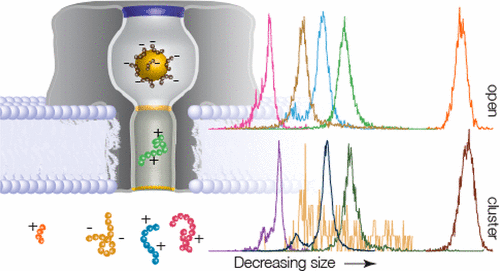Our official English website, www.x-mol.net, welcomes your
feedback! (Note: you will need to create a separate account there.)
Single Molecule Nanopore Spectrometry for Peptide Detection
ACS Sensors ( IF 8.2 ) Pub Date : 2017-08-16 00:00:00 , DOI: 10.1021/acssensors.7b00362 Amy E Chavis 1 , Kyle T Brady 1 , Grace A Hatmaker 1 , Christopher E Angevine 1 , Nuwan Kothalawala 2 , Amala Dass 2 , Joseph W F Robertson 3 , Joseph E Reiner 1
ACS Sensors ( IF 8.2 ) Pub Date : 2017-08-16 00:00:00 , DOI: 10.1021/acssensors.7b00362 Amy E Chavis 1 , Kyle T Brady 1 , Grace A Hatmaker 1 , Christopher E Angevine 1 , Nuwan Kothalawala 2 , Amala Dass 2 , Joseph W F Robertson 3 , Joseph E Reiner 1
Affiliation

|
Sensing and characterization of water-soluble peptides is of critical importance in a wide variety of bioapplications. Single molecule nanopore spectrometry (SMNS) is based on the idea that one can use biological protein nanopores to resolve different sized molecules down to limits set by the blockade duration and noise. Previous work has shown that this enables discrimination between polyethylene glycol (PEG) molecules that differ by a single monomer unit. This paper describes efforts to extend SMNS to a variety of biologically relevant, water-soluble peptides. We describe the use of Au25(SG)18 clusters, previously shown to improve PEG detection, to increase the on- and off-rate of peptides to the pore. In addition, we study the role that fluctuations play in the single molecule nanopore spectrometry (SMNS) methodology and show that modifying solution conditions to increase peptide flexibility (via pH or chaotropic salt) leads to a nearly 2-fold reduction in the current blockade fluctuations and a corresponding narrowing of the peaks in the blockade distributions. Finally, a model is presented that connects the current blockade depths to the mass of the peptides, which shows that our enhanced SMNS detection improves the mass resolution of the nanopore sensor more than 2-fold for the largest cationic peptides studied.
中文翻译:

用于肽检测的单分子纳米孔光谱法
水溶性肽的传感和表征在各种生物应用中至关重要。单分子纳米孔光谱法 (SMNS) 的理念是,可以利用生物蛋白质纳米孔将不同大小的分子解析至由封锁持续时间和噪声设定的极限。先前的工作表明,这可以区分因单个单体单元而异的聚乙二醇(PEG)分子。本文描述了将 SMNS 扩展到各种生物学相关的水溶性肽的努力。我们描述了使用 Au 25 (SG) 18簇(之前已证明可以改善 PEG 检测)来增加肽与孔的结合和解离速率。此外,我们研究了波动在单分子纳米孔光谱 (SMNS) 方法中的作用,并表明修改溶液条件以增加肽的灵活性(通过 pH 或离液盐)可导致当前封锁波动减少近 2 倍以及封锁分布中的峰值相应变窄。最后,提出了一个将当前封锁深度与肽质量联系起来的模型,这表明我们增强的 SMNS 检测将纳米孔传感器的质量分辨率提高了 2 倍以上,对于所研究的最大阳离子肽。
更新日期:2017-08-16
中文翻译:

用于肽检测的单分子纳米孔光谱法
水溶性肽的传感和表征在各种生物应用中至关重要。单分子纳米孔光谱法 (SMNS) 的理念是,可以利用生物蛋白质纳米孔将不同大小的分子解析至由封锁持续时间和噪声设定的极限。先前的工作表明,这可以区分因单个单体单元而异的聚乙二醇(PEG)分子。本文描述了将 SMNS 扩展到各种生物学相关的水溶性肽的努力。我们描述了使用 Au 25 (SG) 18簇(之前已证明可以改善 PEG 检测)来增加肽与孔的结合和解离速率。此外,我们研究了波动在单分子纳米孔光谱 (SMNS) 方法中的作用,并表明修改溶液条件以增加肽的灵活性(通过 pH 或离液盐)可导致当前封锁波动减少近 2 倍以及封锁分布中的峰值相应变窄。最后,提出了一个将当前封锁深度与肽质量联系起来的模型,这表明我们增强的 SMNS 检测将纳米孔传感器的质量分辨率提高了 2 倍以上,对于所研究的最大阳离子肽。











































 京公网安备 11010802027423号
京公网安备 11010802027423号